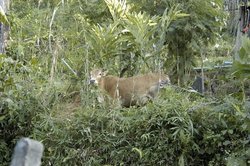Water Buffalo
|
|
| Water Buffalo | ||||||||||||||||
|---|---|---|---|---|---|---|---|---|---|---|---|---|---|---|---|---|
| Missing image Water_buffalo_bathing.jpg A family of Water Buffalo bathing in a sinkhole, Taiwan | ||||||||||||||||
| Scientific classification | ||||||||||||||||
| ||||||||||||||||
| Binomial name | ||||||||||||||||
| Bubalus arnee (Kerr, 1792) |
The Water Buffalo is a very large ungulate. It survives in the wild in India, Nepal, Bhutan and Thailand and is very widespread as a domestic animal in Asia, South America, North Africa and Europe. It is feral in northern Australia. Wild-living populations also exist in much of South-east Asia but their origin is uncertain: they may be the descendants of wild Water Buffalo, formerly domesticated ferals or a mixture of both. In Asia the population of wild Water Buffalo has become very sparse. Adults range in size from 300 kg to 1200 kg, although females typically weigh around 750 kg and males upwards of 1000 kg. Due to genetic isolation weights can vary greatly even in populations in close proximity. Buffalo seem to have originated from South Asia, from India to Indochina.
The classification of the Water Buffalo is uncertain. Some authorities list a single species, Bubalus arnee with two subspecies, the River (B. arnee bubalis) and Swamp (B. arnee carabanesis) Water Buffaloes; others regard them as closely related but separate species. The Swamp Buffalo has 48 chromosomes, and is mostly found in the eastern half of Asia. The River Buffalo is mostly found in western half of Asia, and has 50 chromosomes. Fertile offspring occurs between the two. It does not readily hybridise with cattle which have 60 chromosomes.
Milk from both of these animals may be used by many peoples, and is the traditional raw material for mozzarella cheese and curd due to its higher fat content. Meat of buffaloes have traditionally been eaten in Asia and is called Carabeef. It is often passed off as beef in certain regions and is also a major source of export revenue for India which has the largest population of buffaloes in the world. Water buffalo hide provides a tough and useful leather often used for shoes and motorcycle helmets.
| Contents |
Asia
Native home of the water buffalo, 95% of world population of water buffalo is located in Asia. Many Asian countries depend on the water buffalo as its primary bovine species. It is valuable for its meat and milk as well as the labour it performs. As of 1992 the Asian population was estimated at 141 million. Buffalo butterfat is the major source of cooking oil in some Asian countries. Its success in Asia is evident by its extensive range. Both variants occur in Asia. River Buffalo are found in elevations of 2,800 m in Nepal, and Swamp Buffalo are found throughout the lowland tropics. Part of their success is due to their ability to thrive on poor foodstuffs and yet be valuable economically.
In the wild, very few pockets of buffalo exist. The Indian wild buffalo or Indian Bison is found in India, Nepal, Bhutan and Thailand. This buffalo has the largest horns of any living animal. The average spread is about 1 m (3 ft 3 in), but one bull shot in 1955 had horns measuring 4.24 m (13 ft 11 in) from tip to tip along the outside curve across the forehead. These massive battering rams ensure that in the wild this is a beast that even its predator the tiger seldom attacks a fully grown male.This makes the buffalo a very dangerous animal if provoked. They are generally found in swamplands and grass jungles and move in herds.
Australia
Introduced into the Northern Territory early in the 19th century as a beast of burden, it quickly escaped and is now feral. As a result of its feral status it is hunted, Melville Island is a popular hunting location, where a steady population of up to 4,000 individuals exist. Buffaloes are also found in Arnhem Land and the Top End. Safari outfits run out of Darwin to Melville Island and other locations in the Top End often with the use of bush pilots. The government has unsuccessfully attempted several eradication programs.
The buffaloes live mainly in freshwater marshes and billabongs, and their range can be quite expansive during the Wet. They have developed a different appearance from the Indonesian buffaloes from which they descend.
Europe and Near East
Introduced into North Africa and the Near East by 600 AD. The water buffalo was brought to Europe with returning Crusaders, and herds can be found in Bulgaria and Italy. As in Asia, buffaloes of the Middle East and Europe live on course vegetation on the marginal land traditionally left to the peasants. They are an economic asset by serving as a protein source, draft animal, and storage of family wealth. In some areas, they also provide recreation at annual racing festivals. These buffalo are mostly River Buffaloes and due to genetic isolation have adopted a distinct look.
Clipart and Animal Pictures
- Clipart (https://classroomclipart.com/image/category/clipart.htm)
- Animal Clipart (https://classroomclipart.com/image/category/animal-clipart.htm)
- Animal Animated Clipart (https://classroomclipart.com/clipart/Animations/Animals.htm)
- Pictures of Animals (https://classroomclipart.com/image/category/animal-photos.htm)
- Amphibian Clip Art, Pictures and Photogaphs (https://classroomclipart.com/image/category/amphibian-clipart.htm)
- Farm Animal Clip Art, Pictures and Photographs (https://classroomclipart.com/image/category/farm-animal-clipart.htm)
- Mammal Clip Art, Pictures and Photographs (https://classroomclipart.com/image/category/mammal-clipart.htm)
- Marine Animal Clip Art, Pictures and Photographs (https://classroomclipart.com/image/category/marine-life-clipart.htm)
- Reptile Clip Art, Pictures and Photographs (https://classroomclipart.com/image/category/reptile-clipart.htm)
- Spider Clip Art, Pictures and Photographs (https://classroomclipart.com/image/category/spider-clipart.htm)
External links
- Wild Water Buffalo (http://www.animalinfo.org/species/artiperi/bubaarne.htm) from http://www.animalinfo.org
- Pet Facts: Buffaloes (http://www.abc.net.au/creaturefeatures/facts/buffalo.htm)
- Water Buffalo (http://ww2.netnitco.net/users/djligda/wbfacts.htm) by David J. Ligda
- Asiatic Water Buffalo (http://www.lioncountrysafari.com/AnimalInfo/WaterBuffalo.htm|) from Lion County Safari (http://www.lioncountrysafari.com|)




